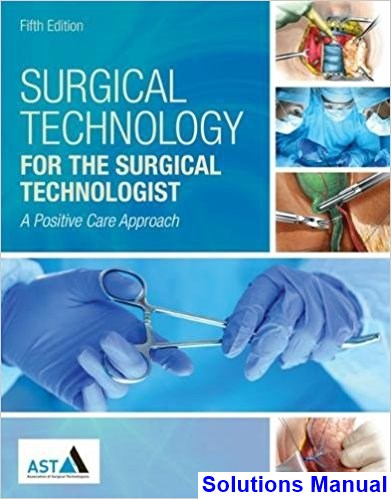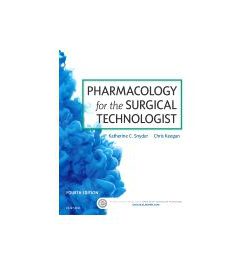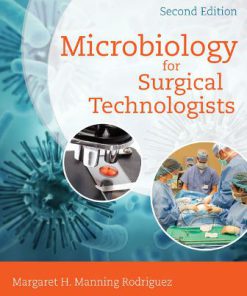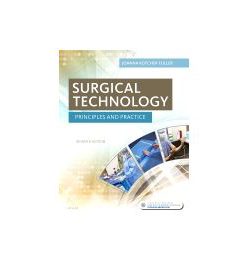Surgical Technology for the Surgical Technologist A Positive Care Approach 5th Edition Association of Surgical Technologists Solutions Manual
$35.00 Original price was: $35.00.$26.50Current price is: $26.50.
Surgical Technology for the Surgical Technologist A Positive Care Approach 5th Edition Association of Surgical Technologists Solutions Manual
This is completed downloadable of Surgical Technology for the Surgical Technologist A Positive Care Approach 5th Edition Association of Surgical Technologists Solutions Manual

Product Details:
- ISBN-10 : 9781305956414
- ISBN-13 : 978-1305956414
- Author: AST Association of Surgical Technologists
Packed with detailed, full-color illustrations and live surgery images, market-leading SURGICAL TECHNOLOGY FOR THE SURGICAL TECHNOLOGIST: A POSITIVE CARE APPROACH, 5e, delivers the most up-to-date and comprehensive coverage of over 200 essential surgical procedures. It also includes essential topics such as equipment and supplies, operative preparation, practical and technical considerations, and postoperative considerations. ‘Pearls of Wisdom’ features offer practical insight from surgical technologists in the field, and numerous learning resources help you maximize your course success — including ‘A POSITIVE CARE’ memory tool, real-life case studies with critical thinking questions, and the powerful digital learning solution MindTap. Preparing you for real-world practice, SURGICAL TECHNOLOGY FOR THE SURGICAL TECHNOLOGIST, 5e, is the ultimate resource for helping you anticipate the patient’s and surgeon’s needs before, during, and after a surgical procedure.
Table of Content:
- Section 1 Introduction to Surgical Technology
- Chapter 1 Orientation to Surgical Technology
- History of Surgery
- History of Surgical Technology
- The Surgical Team
- Nonsterile Surgical Team Members
- Sterile Surgical Team Members
- Areas of Specialty and Classification of Procedures
- Specialties
- Classification of Surgery
- Surgical Technology Profession
- Surgical Technology Education and Certification
- AST: Professional Organization for Surgical Technology
- Career Development and Opportunities
- Job Descriptions
- Resume Preparation
- Interview Preparation
- Resignation
- Clinical Ladder Programs
- The Surgical Technologist’s Lifestyle
- Teamwork and Communication
- Teamwork in Surgery
- AST Position Statement on Teamwork
- Communication
- Interdepartmental Communication
- Hospital Organization
- Hospital Departments and Interdepartmental Communication
- Financial Considerations and Reimbursement
- Professional Organizations
- Chapter 2 Legal Concepts, Risk Management, and Ethical Issues
- Legal Issues
- Definitions of General Legal Terms
- Definitions of Legal Doctrines and Traditional Principles
- Torts
- Intentional Torts
- Unintentional Torts
- Consent for Surgery: A Basic Right
- Informed Consent
- Documentation
- Sentinel Event/Incident Reports
- Advance Directives
- AHA Patient Care Partnership
- Risk Management and Liability
- Medical Errors
- The Safe Medical Device Act
- Managing Patient and Employee Injuries
- Malpractice Insurance
- Health Insurance Portability and Accountability Act (HIPAA)
- Ethical and Moral Issues
- Moral Principles
- Elements of Ethical Decision Making
- Professional Codes of Conduct
- Scope of Practice
- Credentialing
- Accreditation and Core Curriculum
- Chapter 3 The Surgical Patient
- The Surgical Technologist and the Surgical Patient
- Prioritizing Needs: Maslow’s Hierarchy
- A Sample Application of Maslow’s Hierarchy
- Cultural and Religious Influences
- Sample Application: Using Religious and Cultural Information in the OR
- Physical, Psychological, Social, and Spiritual Needs of the Surgical Patient
- Understanding the Surgical Patient as a Human Being
- Causes of Surgical Intervention
- Patient Responses to Illness and Hospitalization
- Death and Dying
- Chapter 4 Special Populations
- Introduction
- Pediatric Patients
- Monitoring the Pediatric Patient
- Temperature
- Urine Output
- Cardiac Function
- Oxygenation
- Shock
- Fluids and Electrolytes
- Infection
- Metabolic and Nutritional Responses
- Trauma
- Key Differences in Treatment
- General Principles of Pediatric Emergency Treatment
- Trauma During Birth
- Child Abuse
- Obese Patients
- Review of Surgical Considerations
- Specific Considerations of Bariatric Surgery
- Complications after Gastric Surgery
- Gallstones
- Degenerative Osteoarthritis
- Diabetic Patients
- Complications Associated with Diabetes
- Care of the Patient with Diabetes in Surgery
- Pregnant Patients
- Considerations When Caring for Pregnant Patients
- Anesthesia
- Intraoperative Considerations for the Surgical Technologist
- Immunocompromised Patients
- Acquired Immunodeficiency Syndrome (AIDS)
- Physically Challenged or Sensory Impaired Patients
- Isolation Patients
- Geriatric Patients
- Substance Abuse Patients
- Trauma Patients
- The “Golden Hour” and Trauma System
- Kinematics
- Blunt Trauma
- Penetrating Trauma
- Trauma Scoring
- Considerations for the Surgical Technologist
- Post-Traumatic Stress Disorder Patient
- Chapter 5 Physical Environment and Safety Standards
- The Surgery Department
- Unrestricted Areas
- Semi-Restricted Areas
- Restricted Areas
- Components Within the Operating Room
- Electrical Outlets
- Suction Outlets
- Gas Outlets
- Lights
- Environmental Control of the OR
- Doors
- Computers
- Viewing Boxes and Monitors
- Cabinets
- Booms
- Standard Operating Room Furniture
- Physical Hazards
- Ionizing Radiation
- Electrical Hazards
- Fire Hazards
- Ergonomics Safety
- Lights
- Noise
- Equipment Hazards
- Biological Hazards
- Standard Precautions
- Latex
- Surgical Plume
- Sharps Safety
- Neutral Zone
- Management of Exposure
- Hazardous Waste Disposal
- Chemical Hazards
- Waste Anesthetic Gases
- Polymethyl Methacrylate
- Formalin
- Ethylene Oxide
- Glutaraldehyde
- Regulatory Agencies
- Section 2 Princip les and Practice of Surgical Technology
- Chapter 6 Biomedical Science and Minimally Invasive Surgery
- Introduction
- Computers
- Hardware
- Software
- Word Processing
- Presentation Platforms
- Internet Basics
- Accessing the Internet
- Information Sources
- Importing Images from the Internet
- Internet Research
- Intellectual Property and Plagiarism
- Perioperative Electronic Communications
- Computers in Health Care
- Electronic Medical Records
- Scheduling Surgical Procedures
- Surgeons’ Preference Cards
- Sterile Processing Documentation
- Annual Staff Competency Training
- Electricity
- Basic Principles of Electricity
- Matter and Atomic Particles
- Conductors and Insulators
- Electrical Currents
- Magnetism and Electricity
- Magnetic Fields
- Electromagnets
- Electrical Circuits
- Power, Load, and Switch
- Wall Outlets
- Direct Current and Alternating Current
- Radio Frequency
- Isolated Power Systems in the OR
- The Electrosurgical Unit
- ESU Circuit
- Monopolar Electrosurgical Units
- Bipolar Electrosurgical Units
- Advantages of Electrosurgery
- Hazards to the Patient and Surgical Team
- Alternative Energies
- Ultrasonic Energy
- Plasma Vaporization
- Lasers
- Benefits of Minimally Invasive Surgery
- Methods of Access
- Natural Body Orifices
- Transcutaneous Access
- Distention Methods
- Visualization in MIS
- Surgical Robots
- Terminology
- da Vinci® Robotic System
- Telesurgery
- Advantages of Remote Robotic Manipulation
- Manipulators
- Voice-Activated Control System, Hearing and Vision
- Alternative Robotic and Guided Imaging Systems
- Merging Surgery, Radiology, and Guided Imaging
- Hybrid Suite Design
- Hybrid OR Procedures
- Advantages of Hybrid Care for Patients
- Chapter 7 Preventing Perioperative Disease Transmission
- General Characteristics of Microbes
- Human–Microbe Relationships
- Pathogens Associated with Surgical Site Infection
- Bacteria
- Tuberculosis
- Viruses
- Emerging Infectious Diseases
- Prions
- Parasites
- Fungi
- Prevention of Disease Transmission
- Natural Lines of Defense
- Safe Work Practices
- Transmission-Based Precautions
- Methods of Transmission
- Sources of Surgical Site Infections
- Factors That Increase Risk of Surgical Site Infection
- Introduction
- Basic Terminology
- Classification of Patient Care Items
- AST Recommended Standards of Practice Applicable to Decontamination and Sterilization
- Disinfection Principles and Disinfecting Agents
- Disinfectant Efficiency
- High-Level Disinfectant Compounds
- Intermediate-Level Disinfectant Compounds
- Environmental Decontamination
- Environmental Services
- Surgical Instrument Decontamination Process
- Sterilization Principles and Processes
- Instrument Preparation and Wrapping
- Steam Sterilization
- Hydrogen Peroxide Gas Plasma
- Liquid Chemical Sterilization Processes
- Ionizing Radiation
- Alternative Sterilization Methods
- Administrative Controls of Sterilization Processes
- Event-Related Sterility
- Surgical Conscience
- Principle 1: A Sterile Field Is Created for Each Surgical Procedure
- Principle 2: Sterile Team Members Must Be Appropriately Attired Prior to Entering the Sterile Field
- Principle 3: Movement in and Around the Sterile Field Must Not Compromise the Sterile Field
- Sterile to Sterile
- Nonsterile to Nonsterile
- Chapter 8 Emergency Situations and All-Hazards Preparation
- Indications of Emergency Situations
- Objectives and Priorities in Emergency Situations
- Cardiopulmonary Resuscitation
- Cardiac Arrest in the Surgical Setting
- Malignant Hyperthermia
- Disseminated Intravascular Coagulation
- Anaphylactic Reactions
- All-Hazards Preparation
- Natural Disasters
- Man-made Disasters
- Personal Disaster Planning
- Local/Community/Regional Response
- Federal Emergency Response
- Health Care Facility Emergency Response
- Immediate Response to an All-Hazards Event
- Chapter 9 Surgical Pharmacology and Anesthesia
- Drug Sources
- Properties of Pharmalogical Agents
- Pharmacokinetics
- Absorption
- Distribution
- Biotransformation
- Excretion
- Pharmacodynamics
- Drug Interactions
- Agonists
- Synergistic Agents
- Additive Agents
- Antagonists
- Timing of Interactions
- Selection Criteria
- Classifications
- Medication Effects
- Routes of Administration
- Drug Forms
- Medication Information
- Drug Standards
- Drug Nomenclature
- Legal Drug Classifications
- Controlled Substances
- Prescription Medications
- FDA Pregnancy Drug Categories
- Over-the-Counter Medications
- Alternative Medication Supplements
- Medication Orders
- Medication Calculations
- Concentration
- Dose
- Application
- Calculating Medication Dosages
- Concentration
- Cumulative Dose and Metric Conversion
- Percentages
- Conversion of Temperature
- Units of Measure
- Metric System
- Metric, Household, and Apothecary Systems of Measurement
- Abbreviations Related to Medication Administration
- Medication Handling Techniques
- Medication Identification
- Pharmaceutical Agents Used in Surgical Specialties
- General Surgery
- Obstetric and Gynecologic Surgery
- Otorhinolaryngologic Surgery
- Genitourinary Surgery
- Orthopedic Surgery
- Cardiovascular Surgery
- Neurosurgery
- Ophthalmic Surgery
- Surgical Hemostasis
- Systemic Factors Affecting Hemostasis
- Control of Bleeding During Surgery
- Bone Wax
- Chemical Methods of Hemostasis
- Absorbable Gelatin
- Hemostatic Matrix
- Absorbable Microfibrillar Collagen
- Oxidized Cellulose
- Silver Nitrate
- Epinephrine
- Thrombin
- Fibrin Sealants
- Vital Signs
- Temperature
- Pulse
- Respiration
- Blood Pressure
- Monitoring Devices
- Electrocardiogram
- Blood Pressure Monitor
- Arterial and Venous Catheterization
- Temperature Monitors
- Pulse Oximeter
- Bispectral Index™ (BIS) Monitor
- SARA
- Stethoscope
- Doppler
- Peripheral Nerve Stimulator
- Arterial Blood Gases
- Anesthesia Equipment
- Anesthesia Machine
- Airway Delivery/Maintenance Devices
- Hypothermia and Hyperthermia Devices
- Methods and Techniques of Anesthetic Administration
- Team Member Roles During Anesthesia Administration
- Preoperative Visits
- General Anesthesia
- Depth of General Anesthesia
- Phases of General Anesthesia
- Team Member Duties in General Anesthesia
- Advantages of General Anesthesia
- Risks and Complications Associated with General Anesthesia
- Cricoid Pressure
- Laryngospasm and Bronchospasm
- Malignant Hyperthermia
- Pseudocholinesterase Deficiency Syndrome
- Allergic Reaction
- Shock
- Cardiac Dysrhythmias
- Cardiac Arrest
- Anesthetic Agents
- Inhalation Agents
- Oxygen
- Nitrous Oxide
- Volatile Agents
- Intravenous Agents
- Induction Agents
- Dissociative Agents
- Opiate/Opioids
- Narcotic Antagonists
- Benzodiazepines
- Benzodiazepine Antagonists
- Neuromuscular Blockade
- Nondepolarizing Agents
- Depolarizing Agents
- Neuromuscular Blockade Antagonism
- Other Agents Commonly Used During Anesthesia Administration
- Antimuscarinic Agents
- Nonsteroidal Anti-Inflammatory Drugs
- Gastric Acid Management
- Lubricants
- Antiemetics
- Solutions Used in the Operating Room Setting
- Adjuncts to General Anesthesia
- Induced Hypothermia
- Induced Hypotension
- Neuroleptanalgesia and Neuroleptanesthesia
- Nerve Conduction Blockade
- Nerve Conduction Blocking Agents
- Amino Amide Group
- Amino Ester Group
- Adjunctive Agents to Nerve Conduction Blockade
- Topical Anesthesia
- Local Anesthesia
- Monitored Anesthesia Care
- Regional Anesthesia
- Nerve Plexus Block
- Bier Block
- Spinal Block
- Epidural Anesthesia
- Team Member Duties in Spinal Anesthesia
- Nontraditional Anesthesia Options
- Postanesthesia Care
- Chapter 10 Instrumentation, Equipment, and Supplies
- Instrumentation
- Classifications
- Cutting/Dissecting
- Scalpels
- Scissors
- Grasping/Holding
- Clamping/Occluding
- Retracting/Viewing
- Probing
- Dilating
- Suturing
- Suctioning
- Microinstrumentation
- Instrument Care and Handling
- Types of Instrument Sets
- Laparotomy Set
- Instrument List/Count Sheet
- Specialty Equipment
- Endoscopes
- Powered Instruments
- Microscopes
- Magnification
- Illumination
- Video Monitors, Recorders, and Cameras
- Fiber-Optic Headlamps and Light Sources
- Pulse Lavage Irrigator
- Phacoemulsifier and Irrigation/Aspiration Units
- Cryotherapy Units
- Insufflators
- Nerve Stimulators
- Accessory Equipment
- Suction Systems
- Lights
- Pneumatic Tourniquets
- Sequential Compression Devices
- Supplies
- Drapes
- Drape Materials
- Drape Types
- Sterile Packs
- Sponges and Dressings
- Surgical Dressings
- Dressing Types
- Catheters, Tubes, and Drains
- Catheters
- Urinary Catheters
- Intravascular Catheters
- Specialty Catheters
- Tubes
- Gastrointestinal Tubes
- Airway Tubes
- Chest Tubes
- Drains
- Irrigators and Syringes
- Chapter 11 Hemostasis, Wound Healing, and Wound Closure
- Introduction
- Blood Loss, Hemostatic Methods, and Blood Replacement
- Blood Loss
- Factors Affecting Hemostasis
- Mechanical Hemostasis
- Biological Hemostasis
- Thermal Hemostasis
- Chemical Hemostasis
- Blood Replacement
- Types of Wounds
- Intentional Wounds
- Unintentional Wounds
- Incidental and Chronic Wounds
- Inflammatory Process
- Types of Wound Healing
- First Intention (Primary Union)
- Phases of Wound Healing by First Intention
- Second Intention (Granulation)
- Third Intention (Delayed Primary Closure)
- Factors Influencing Wound Healing
- Patient’s Physical Condition
- External Factors
- Suture Techniques and Prevention of Infection
- Complications of Wound Healing
- Classification of Surgical Wounds
- Class I: Clean
- Class II: Clean Contaminated
- Class III: Contaminated
- Class IV: Dirty/Infected
- Postoperative Wound Care
- Wound Drains
- Dressings
- Wound Closure
- Classification of Suture Materials
- Factors Affecting Surgeon Selection of Suture
- Suture Materials
- Suture Sizes and Tensile Strength
- Packaging of Suture
- Ligatures
- Free-Tie
- Ligature Reel
- Instrument Tie (Tie-on-a-Pass)
- Suture Ligature (Stick Tie)
- Suture Preparation for the Procedure
- Placement on Field
- Loading the Suture
- Cutting Suture
- Surgical Needles
- Needle Eyes
- Needle Points
- Needle Bodies
- Surgical Specialty Needles
- Layer Closure
- Peritoneum
- Fascia
- Muscle
- Subcutaneous
- Subcuticular
- Skin
- Suturing Techniques
- Continuous Suturing Techniques
- Interrupted Suturing Techniques
- Traction Sutures
- Secondary Suture Line
- Retention
- Endoscopic Suturing
- Alternative Skin Closure Methods
- Accessory Devices
- Bridges and Bolsters
- Buttons and Lead Shots
- Umbilical Tape
- Vessel Loops
- Suture Anchors
- Adhesive Skin Closure Tapes
- Skin Adhesive
- Stapling Devices
- Types of Staplers
- Meshes and Fabrics
- Chapter 12 Surgical Case Management
- Introduction
- Anticipation
- Preoperative Patient Routines
- Circulator Role/Responsibilities
- Patient Preparation
- Diet
- Enemas
- Preoperative Hygiene
- Preoperative Hair Removal
- Makeup and Dress
- Nail Polish
- Patient Possessions
- Preoperative Education
- Sedation
- Patient Transport to OR
- Transfer and Positioning to OR Table
- Thermoregulatory Devices
- Vital Signs
- Positioning the Surgical Patient
- Supine Position
- Trendelenburg Position
- Reverse Trendelenburg Position
- Fowler’s Position and Sitting Position
- Lithotomy Position
- Prone Position
- Kraske (Jackknife) Position
- Lateral Position
- Kidney Position
- Sims’ Position
- Urethral Catheterization
- Open Gloving
- Indications for Urethral Catheterization
- Considerations for Urethral Catheterization
- Urethral Catheterization Supplies
- Patient Skin Preparation
- Single Use
- Abdominal and Thoracoabdominal Preparations
- Chest and Breast
- Eyes, Ears, Face, and Nose
- Extremities
- Leg and Hip Procedures
- Hand and Arm Procedures
- Perineal and Vaginal Preps
- Attire for Surgical Technologist in Scrub Role Responsibilities
- OR Attire
- Hair Cover
- Scrub Suit
- Mask
- Shoe Covers
- Protective Attire
- Protective Eyewear
- Radiation Protection
- Other Protective Attire
- Sterile Attire
- Sterile Gown
- Sterile Gloves
- Preparing the Operating Room
- Operating Room Setup
- Gathering Instrumentation and Supplies
- Creating and Maintaining the Sterile Field
- Opening Sterile Supplies
- Scrubbing and Donning Sterile Attire
- Preparation of the Sterile Field
- Draping the Mayo Stand
- Organizing the Sterile Instruments and Supplies
- Preoperative Count
- Electronic Methods of Tracking Surgical Counts
- Assisting a Team Member
- Draping the Surgical Patient
- Problem Solving
- Draping the Abdomen
- Draping the Perineum
- Draping an Extremity
- Draping for Craniotomy
- Placement of the Sterile Team and Furniture
- Time Out
- Marking the Skin Incision
- General Principles
- Safety
- Intraoperative Communication
- Verbal Communication
- Nonverbal Communication
- Passing the Instruments (and Other Supplies)
- Maintaining Order Within the Sterile Field
- Progression of the Surgical Procedure
- Receiving Additional Supplies to Sterile Field
- Intraoperative and Closing Counts
- Sponges
- Sharps
- Instruments
- Medication Handling
- Specimen Care
- Changing Contaminated Sterile Attire
- Care of the Incision Site and Dressing Application
- Preservation of the Sterile Field
- Drape Removal
- Gown and Glove Removal
- Immediate Postoperative Patient Care
- Patient Transfer and Transportation
- Breakdown of the Setup
- Section 3 Surgical Procedures
- Chapter 13 Diagnostic Procedures
- Sources of Patient Data
- History and Physical Examination
- Diagnostic Imaging
- Ionizing Radiation
- Plain Radiography
- Mammography
- Radiopaque Contrast Media Imaging
- Radioisotope Imaging
- Magnetic Resonance Imaging
- Ultrasonography
- Doppler Ultrasonography
- Plethysmography and Phleborheography
- Electrodiagnostic Studies
- Electrocardiography
- Electroencephalography
- Electromyography
- Intraoperative Neuromonitoring
- Pulmonary Assessment
- Pulse Oximetry
- Capnography
- Spirometry
- Blood Gases
- Laboratory Studies
- Urinalysis
- Bacteriological Tests
- Surgical Specimens
- Types of Surgical Specimens
- Spinal Tap
- Endoscopy
- Care and Handling of Surgical Specimens
- Chapter 14 General Surgery
- Overview
- Instrumentation, Routine Equipment, and Supplies
- Instrumentation
- Intestinal Instruments
- Incisions
- Laparotomy
- Surgery of the Alimentary Canal
- Esophageal Pathology
- Pathological Conditions of the Stomach
- Total Gastrectomy
- Bowel Pathology
- Bowel Technique
- Appendectomy
- Stomas
- Anorectal Pathology
- Select Pathology of the Liver and Biliary Tract
- Liver Resection
- Surgical Treatment of Gallbladder Disease
- Conservative Treatment for Cholelithiasis
- Cholecystectomy and Cholangiography
- Surgery of the Pancreas and Spleen
- Cancer of the Pancreas
- Pancreatectomy
- Pancreaticoduodenectomy
- Hernias
- Hernia Repair
- Breast Surgery
- Breast and Axilla: Pathology and Diagnosis
- Surgery of the Thyroid and Parathyroid
- Thyroidectomy
- Chapter 15 Obstetric and Gynecologic Surgery
- Introduction to Obstetric and Gynecologic Surgery
- Instrumentation, Equipment, and Supplies in Obstetric and Gynecologic Surgery
- Instrumentation
- Equipment
- Supplies
- Patient Positioning, Draping, and/or Setup
- Surgical Procedures: Obstetrics
- Labor
- Normal Role of Surgical Technologist in Delivery
- Episiotomy and Perineal Lacerations
- Incompetent Cervix
- Surgical Procedures: Gynecologic Procedures
- Abdominal Incisions for Gynecologic Surgery
- Diagnostic Procedures
- Surgical Procedures of the External Genitalia and Structures
- Cervical Surgical Procedures
- Chapter 16 Ophthalmic Surgery
- Introduction to Ophthalmic Surgery
- Instruments, Routine Equipment, and Supplies
- Instruments
- Routine Equipment
- Routine Supplies
- Surgical Intervention
- Practical Considerations
- Procedural Considerations
- Cataract Extraction
- Chapter 17 Otorhinolaryngologic Surgery
- Introduction to Otorhinolaryngologic Surgery
- Ear Procedures
- Diagnostic Procedures and Tests
- Routine Instruments, Equipment, and Supplies
- Practical Considerations
- Nasal Procedures
- Diagnostic Procedures and Tests
- Direct Vision
- Mirror Examination
- Radiography
- Routine Instruments, Equipment, and Supplies
- Practical Considerations
- Submucous Resection (SMR)
- SMR/Septoplasty
- Intranasal Antrostomy
- Oral Cavity and Throat Procedures
- Diagnostic Procedures and Tests
- Direct Visualization
- Indirect Visualization
- Laboratory Tests
- Radiologic Examinations
- Videostroboscopy
- Polysomnography
- Multiple Sleep Latency Test (MSLT)
- Routine Instruments, Equipment, and Supplies
- Practical Considerations
- Chapter 18 Oral and Maxillofacial Surgery
- Introduction to Oral and Maxillofacial Surgery
- Diagnostic Tests
- Tooth Extraction/Odontectomy
- Routine Instruments, Equipment, and Supplies
- Routine Equipment
- Routine Supplies
- Practical Considerations
- Procedural Considerations
- Maxillofacial Procedures: General Considerations
- General Considerations
- Repair of Mandibular/Maxillary Fractures
- Orthognatic Surgery
- Chapter 19 Plastic and Reconstructive Surgery
- Introduction
- Diagnostic Procedures and Tests
- Instrumentation, Routine Equipment, and Supplies
- Instrumentation
- Plastic Sets
- Nasal Set
- Equipment
- Oscillating-Blade Dermatome
- Other Types of Dermatomes
- Skin Graft Procedures
- Skin Grafts
- Scar Revision
- Head and Face Procedures
- Hand Procedures
- Breast Procedures
- Abdominal Procedures
- Chapter 20 Genitourinary Surgery
- Introduction
- Diagnostic Procedures and Tests
- History and Physical
- Laboratory Findings
- Hematology Findings
- Urinalysis
- Composition of Urine
- Radiologic Findings
- Biopsy
- Endoscopy
- Instrumentation, Routine Equipment, and Supplies
- Instrumentation
- Equipment
- Supplies
- Incisional Options
- Inguinal Incision
- Scrotal Incision
- Abdominal Incisions
- Gibson Incision
- Flank Incisions
- Lumbar Incision
- Kidney, Ureter, and Bladder Surgical Procedures
- Nephrectomy
- GU Endoscopy
- Cystectomy/Ileal Conduit
- Procedures for Stress Incontinence Affecting Women
- Suburethral Sling (Pubovaginal Sling)
- Prostate Surgery
- Percutaneous Implantation of Radioactive Seeds in the Prostate Gland
- Testicular Surgery
- Penile Surgical Procedures
- Chapter 21 Orthopedic Surgery
- Bone and Bone Tissue
- Bone Tissue
- Types of Bones
- Types of Joints
- Terms Related to Joint Movements
- Pathology
- Diagnostic Procedures and Tests
- Instrumentation, Routine Equipment, and Supplies
- Instrumentation
- Routine Equipment
- Routine Supplies
- Orthopedic Surgical Procedures
- Procedures of the Radius
- Hip Procedures
- Femoral Procedures
- Knee Procedures
- Ankle and Foot
- Chapter 22 Cardiothoracic Surgery
- Introduction
- Diagnostic Procedures and Tests
- Instrumentation, Routine Equipment, and Supplies
- Instrumentation
- Equipment
- Anesthesia Monitoring Equipment
- Supplies
- Introduction
- Anatomy and Physiology of the Heart
- Location of the Heart
- Coverings of the Heart
- The Heart Wall
- The Heart Chambers
- The Heart Valves
- Blood Flow Through the Heart
- Blood Supply for the Heart
- Cardiac Conduction
- Diagnostic Procedures and Tests
- Routine Instrumentation, Equipment, and Supplies
- Instrumentation
- Equipment
- Supplies
- Techniques of Cardiopulmonary Bypass
- Mitral Valve Replacement
- Introduction
- Preoperative Preparation
- Ventricular Septal Defect
- Chapter 23 Peripheral Vascular Surgery
- Peripheral Vascular Surgery
- Diagnostic Procedures and Tests
- Instrumentation, Supplies, and Equipment
- Instrumentation
- Supplies
- Biologic and Synthetic Grafts
- Equipment
- Peripheral Vascular Surgical Procedures
- Chapter 24 Neurosurgery
- Introduction to Neurological Surgery
- Instruments, Routine Equipment, and Supplies
- Instruments
- Spinal
- Peripheral
- Routine Equipment
- Routine Supplies
- Surgical Intervention
- Cranial Procedures
- Practical Considerations
- Procedural Considerations
- Spinal Procedures
- Practical Considerations
- Procedural Considerations
- Peripheral Nerve Procedures
- Practical Considerations
- Procedural Considerations
- Appendix A Anatomy Plates
- Index
People Also Search:
surgical technology for the surgical technologist a positive care approach
surgical technology for the surgical technologist a positive care approach 5th
surgical technology for the surgical technologist a positive care approach 5th download pdf
You may also like…
Solution Manual
Medical Surgical Nursing Care 4th Edition Burke Solutions Manual












